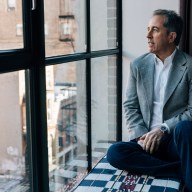NEW YORK – The world of high fashion is coming down to earth a bit.
Trenchcoats, jumpsuits, sumptuous sweater sets and billowy dresses intended to flatter a wider range of body shapes and sizes ruled the runway at New York Fashion Week, which showcased spring 2010 designs for buyers and fashion editors.
It’s a big departure from the elaborately beaded evening gowns and unwearable flights of fancy like see-through pants that have dominated runways in recent years.
The everyday looks are vivid examples of how the industry is responding to a new thriftiness that has extended to the rich, who have grappled with declining net worth since last year’s financial meltdown. Even mega-millionaires have re-evaluated their spending.
And while the luxury business has stabilized a bit since last fall’s freefall, it’s still weak.
Luxury sales fell a little more than 15 per cent from January through August compared with the same-period a year ago, far more than the nine per cent decline for all U.S. apparel sales, according to SpendingPulse, a data service provided by MasterCard Advisors that estimates U.S. retail sales across all payment forms including cash and checks. In past recessions, luxury sales had held up much better than other areas.
After almost a decade of feeding consumers’ increasingly voracious appetite for luxury goods, the industry is catering to shoppers looking at clothes as investments and dressing down for even society galas.
Designers are channelling their creative energies into more practical and less expensive clothing. They are creating lower-price collections and offering more casual and multipurpose clothes like coats that can double as dresses.
Upscale stores such as Neiman Marcus and Saks Fifth Avenue are focusing on low-to mid-tier luxury prices, ordering less and emphasizing clothes that shoppers can wear for several seasons. That means more dresses from US$400 to $600, and fewer above $1,000.
Sure, the price tags are still eye-popping to average Americans. But they’re a dramatic change from the past six years when designers kept pushing prices up and piling on more elaborate trimmings on everything from shoes to handbags.
Designers “want to produce clothes that are going to sell. We are seeing clothes that are well designed but not as experimental,” said Robert Burke, a New York-based luxury consultant and former fashion director at Bergdorf Goodman.
Among the changes:
-Narciso Rodriguez, who burst on the fashion scene when he designed the wedding gown for Carolyn Bessette Kennedy, is broadening his reach under a deal with online auctioneer eBay.com to sell an exclusive clothing line priced from $75 to $350. As for Rodriguez’s signature collection, he’s still designing dresses that are priced at $1,800 and up for the Spring 2010 season, but he is also adding dresses in the $1,000 price range.
-Italian clothing maker Brioni, known for hand-sewn suits priced from $4,700 to $47,000, plans a collection of $250 T-shirts starting in January. They aren’t what you’d find at the mall and feature handstitched Italian embroidery. The company’s casual business now accounts for almost 40 per cent of its sales, up from 15 to 20 per cent three years ago.
-Dress designer Nicole Miller is expanding into casual sportswear with a collection of pants, blouses and skirts for fall 2010.
“The whole luxury business is up for grabs because people are changing their habits,” said Patrick Byrne, CEO of Overstock.com, which sells Prada, Gucci and other top designer brands at up to 40 per cent discounts. The company’s internal research shows a recent influx of wealthier customers – those whose average household incomes were $125,000, compared with $80,000 for its core customers.
Many shoppers have been so burned that they don’t want to go back to spending the way they used to.
“I liked to buy designer clothes when the economy was strong. I would splurge on myself,” said Helana Natt, who has bought Louis Vuitton $700 handbags and evening dresses for $1,000 or more each. “But I am not splurging at all now.”
Natt, a 47-year-old mother of three from Harrison, N.Y., said she has reduced her spending since last fall as her investments took a hit. Two of her three children are also in college now. Natt wants to still support the fashion industry, so when she does buy, she is shopping at designers’ sample sales. And she’s now carefully thinking how long an outfit will last and how much she’ll wear it.
That thinking is helping to shrink the luxury market.
Gilbert Harrison, chairman of Financo Inc., an investment banking firm specializing in retailing, believes that luxury spending levels are reverting back to about 2004. That year, sales for North and South America were about $68.2 billion, well below the 2007 peak of $85.2 billion, according to Bain&Co. Those sales are nearly all in the U.S.
Sara Albrecht, owner of Chicago-based designer store Ultimo agrees with the approach that designers are embracing.
“We are looking at more bang for your buck that you can get out of a piece of clothing,” said Albrecht. “That’s all important, and you need that to make a sale.”
–
A new reality for luxury: Lower prices, more-practical fashions as market shrinks
THE ASSOCIATED PRESS
The luxury world is losing some of the froth as well-heeled consumers, still reeling from the financial meltdown from a year ago, have changed their buying habits. That has forced the fashion industry to create more practical garments at lower prices.
The status report on luxury:
LUXURY SALES: Luxury sales had always been considered recession-proof. That has changed. A freefall in luxury spending late last year among the rich led to unprecedented discounting on even premium brands like Chanel and Prada. And while sales of high-priced items have stabilized in recent months, business is still weak and is faring even worse than overall U.S. apparel sales.
THE SHRINKING LUXURY MARKET: Gilbert Harrison, chairman of Financo Inc., an investment banking firm specializing in retailing, believes that luxury spending levels are reverting back to as early as 2004. That year, sales for North and South America were about US$68.2 billion, well below the 2007 peak of $85.2 billion, according to Bain&Co.
WHAT SHOPPERS WILL SEE IN LUXURY STORES AND ON MAIN STREET: Shoppers will see more merchandise focusing on the low-to mid-tier luxury prices. That means more dresses from $400 to $600, and fewer priced over $1,000. The average prices for European luxury handbags are now anywhere from $1,600 to $1,700, lower than the $2,000 average seen more than a year ago, acccording to Hana Ben-Shabat, a partner in the retail practice of management consultancy A.T. Kearney.
















